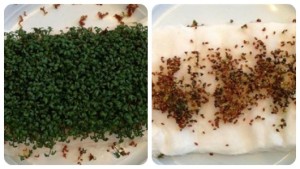Student Science Experiment Finds Plants Won’t Grow Near Wi-Fi Router
HEALTH, ENERGY, MEDIA, EDUCATION, SCIENCE, 10 Jun 2013
Global Research News – TRANSCEND Media Service
Five ninth-grade young women from Denmark recently created a science experiment that is causing a stir in the scientific community.
It started with an observation and a question. The girls noticed that if they slept with their mobile phones near their heads at night, they often had difficulty concentrating at school the next day. They wanted to test the effect of a cellphone’s radiation on humans, but their school, Hjallerup School in Denmark, did not have the equipment to handle such an experiment. So the girls designed an experiment that would test the effect of cellphone radiation on a plant instead.
The students placed six trays filled with Lepidium sativum, a type of garden cress into a room without radiation, and six trays of the seeds into another room next to two routers that according to the girls calculations, emitted about the same type of radiation as an ordinary cellphone.
Over the next 12 days, the girls observed, measured, weighed and photographed their results. Although by the end of the experiment the results were blatantly obvious — the cress seeds placed near the router had not grown. Many of them were completely dead. While the cress seeds planted in the other room, away from the routers, thrived.
The experiment earned the girls top honors in a regional science competition and the interest of scientists around the world.
According to Kim Horsevad, a teacher at Hjallerup Skole in Denmark were the cress experiment took place, a neuroscience professor at the Karolinska Institute in Sweden, is interested in repeating the experiment in controlled professional scientific environments.
Go to Original – globalresearch.ca
DISCLAIMER: The statements, views and opinions expressed in pieces republished here are solely those of the authors and do not necessarily represent those of TMS. In accordance with title 17 U.S.C. section 107, this material is distributed without profit to those who have expressed a prior interest in receiving the included information for research and educational purposes. TMS has no affiliation whatsoever with the originator of this article nor is TMS endorsed or sponsored by the originator. “GO TO ORIGINAL” links are provided as a convenience to our readers and allow for verification of authenticity. However, as originating pages are often updated by their originating host sites, the versions posted may not match the versions our readers view when clicking the “GO TO ORIGINAL” links. This site contains copyrighted material the use of which has not always been specifically authorized by the copyright owner. We are making such material available in our efforts to advance understanding of environmental, political, human rights, economic, democracy, scientific, and social justice issues, etc. We believe this constitutes a ‘fair use’ of any such copyrighted material as provided for in section 107 of the US Copyright Law. In accordance with Title 17 U.S.C. Section 107, the material on this site is distributed without profit to those who have expressed a prior interest in receiving the included information for research and educational purposes. For more information go to: http://www.law.cornell.edu/uscode/17/107.shtml. If you wish to use copyrighted material from this site for purposes of your own that go beyond ‘fair use’, you must obtain permission from the copyright owner.
Read more
Click here to go to the current weekly digest or pick another article:
HEALTH:
- U.S. Terminates Funding for Polio, H.I.V., Malaria and Nutrition Programs Around the World
- Autism, Made in the USA
- Big Pharma Is a Big Menace to Global Health
ENERGY:
- China Opens World’s Largest Offshore Solar Power Facility
- Nuclear Industry Takes Control of NASA
- The Nuclear Energy Dilemma: Climate Savior or Existential Threat?
MEDIA:
- The Media Calls Israeli Captives “Hostages” and Palestinians “Prisoners”
- The Media Navigator (2025)
- Zuckerberg and Musk Have Shown that Big Tech Doesn’t Care about Facts
EDUCATION:
- Misconception and Right Concept of Peace Education: Theory and Praxis
- Financing Higher Education to Build Non-exploitative Society for Peace
- Relevance of Peace Education
SCIENCE:
